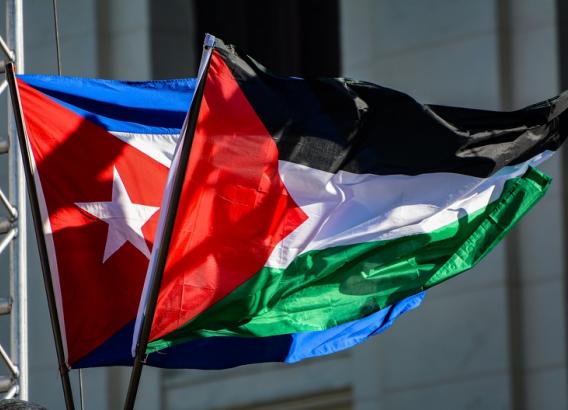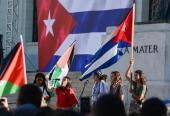Patricia Ariza, a symbol of new Colombia
especiales

She is that woman, the emotional artist, the founding theater artist of the legendary group La Candelaria. Militant of Unión Patriótica in the deep side of Colombia, whom she saw how her brothers of thought and struggle were assassinated one by one and she lived for a long time under death threat. And so, with a bulletproof vest, she went out on stage every night because of her commitment to the theater and to her life. «When the curtain fell, every night after each performance, Patricia Ariza, marked for death, closed her eyes. In silence, she thanked the applause of the public and another day of life, » said Eduardo Galeano in Libro de los Abrazos.
“Patricia belonged to that list of those sentenced to death” —Galeano wrote— “since her thinking was red, as well as her way of living; and those death sentences were fulfilled, one by one. She even went homeless. A bomb could perfectly blow her apartment building: the neighbors, obedient to the law of fear, asked her to leave.”
Today Patricia Ariza is a symbol of the new Colombia. The formerly persecuted artist is now part of Gustavo Petro's Government of Change, as Minister of Culture —MICASA —Cultures, Arts, and Knowledge. She corrects, and the distinction cannot be ignored as it implies inclusion, and the centuries-old wisdom of the peoples.
She arrived at the Havana Book Fair, dedicated to her country, together with Vice President Francia Márquez, another symbol, and a large delegation of writers and artists. In one of the many panels in which she has participated in the literary event —organized by the Minrex under the convenorship of Cuba as pro tempore president of the Group of 77+China, where she shared space with the Minister of Culture of Senegal and Cuban intellectual Enrique Ubieta, we had the privilege of listening to her:
"I am very honored to be here in Cuba, a country with which I have had relations for many years, affective, personal and cultural relations, with the Teatro La Candelaria group, with the theater movement, and now I come as a member of the government of change led by President Gustavo Petro.”
She painfully remembers that her country has experienced a political genocide in recent times: the extermination of the Unión Patriótica, as part of an internal armed conflict with a negative outcome of thousands of deaths, disappearances and nine million victims.
“This war has caused a severe damage. The social structure of Colombia, like that of many countries in the Americas and of countries that have experienced war, is broken, by hatred, by death, by disaffection, by violence.
“And that has a lot to do with the common story. It is very difficult for us to have a shared story, a common legend that unifies us all, because our story has been narrated by the counterinsurgency policy, by the policy of the internal enemy.”
After narrating the extermination that annihilated her organization by the old army and, more recently, the tragedy of the false positives that left more than six thousand young people murdered, an event that "breaks her soul and heart," Patricia strongly believes Colombia is being renewed, regarding the government and the army.
Building up the culture of peace
In this new stage, how to rebuild the social structure? Her own life experience allows her to participate and contribute. “We have to change not only the social conditions of the people, which, of course, are changing, but first Colombia has to make peace. And one of the purposes of this new government is not only to make peace, but total peace,” she pointed out before the audience at the Nicolás Guillén Hall in La Cabaña.
They face this huge challenge from the Ministry of Cultures, Arts and Knowledge. Making peace is not just stopping fire arms, she explains. A country that has lived at war is also a culture. And we must build the culture of peace.
“The victims, the survivors are the ones who have taught us to build this culture of peace. We believe that culture, as Amilcar Cabral said, is made of the responses that peoples are capable of giving to crises. We want peace to become a way of being and thinking, which is why we believe that it is deeply linked to culture, the arts and knowledge.”
The ministry she leads has another strong dream, which is to work against stigmatization, which she considers "is the fuel of war, because first a people, a person, a political movement are stigmatized, and then it is easy to physically annihilate them."
At the same time, Colombia aims to forging a new knowledge, not only from the Academy, but with the help of the arts and culture as a whole: A Knowledge Society, President Gustavo Petro has called it. “I believe that too, but it seems to me that knowledge without sensitivity is useless. You have to be sensitive."
Aware that peace in Colombia is, in fact, the peace of the region and the world’s, Patricia, despite the pains of her life, is optimistic: "We have to see the future of mankind from resistance, from the ability to find relevant solutions. We cannot resign ourselves to sitting and waiting for the end of the world.
"The peoples that have endured such a harsh war like ours, have the authority to talk about peace, because we are building it."
Translated by Sergio A. Paneque Díaz / CubaSí Translation Staff














Add new comment